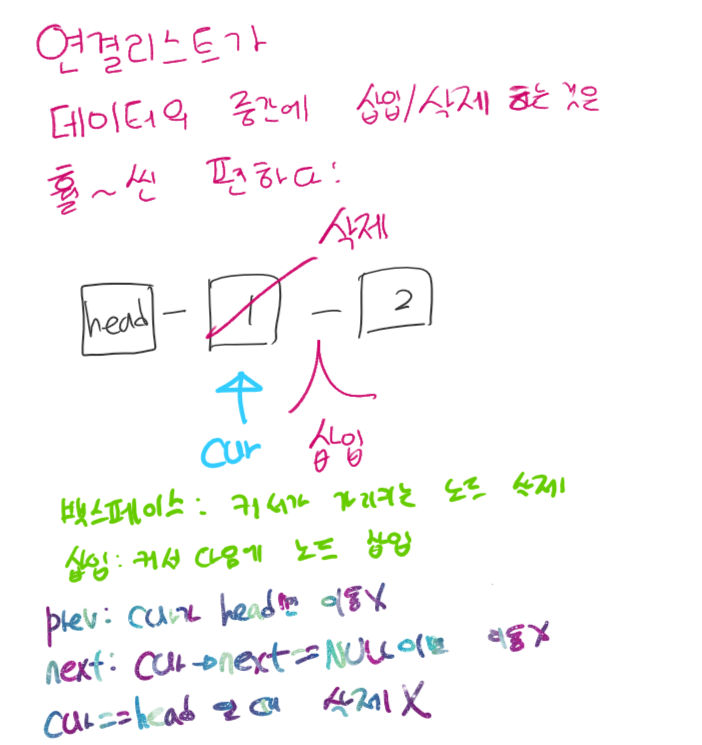


내 코드
#include <stdio.h>
#include <string.h>
#include <stdlib.h>
typedef struct node
{
char data;
struct node* prev;
struct node* next;
}Node;//양방향 연결리스트
void Insert(Node* cur, char data)
{
Node* temp = cur->next;//A B사이에 C를 삽입한다 가정
//A의 next를 C로 하고(1) C의 양쪽에 A,B를 연결해야 하고(2),(3), B의 prev를 C로 해야한다.(4)
cur->next = malloc(sizeof(Node));//cur는 A, A의 next는 C/(1)
cur->next->data = data;//C에 데이터를 삽입
cur->next->next = temp;//C의 next는 B/(3)
if(temp != NULL) temp->prev = cur->next;//B가 NULL이 아니면 B의 이전애 C를 연결/(4)
cur->next->prev = cur;//C의 이전은 A/(2)
}
Node* Delete(Node* cur)
{
Node* temp_next = cur->next;
Node* temp_prev = cur->prev;
temp_prev->next = temp_next;
if(temp_next != NULL) temp_next->prev = temp_prev;//삭제되는 데이터의 next가 NULL일 때는 예외처리, NULL이 아니면 그 노드의 prev는 'cur의 prev'이다.
free(cur);
return temp_prev;
}
int main()
{
int T;
int i, j, length;
char array[1000001];
scanf("%d", &T);
for (j = 0; j < T; j++)
{
Node* head = malloc(sizeof(Node));
Node* cur = head;
cur->prev = NULL;
cur->next = NULL;//헤드만들고 처음에 커서가 헤드를 가리키게 함
scanf("%s", array);
length = strlen(array);
for (i = 0; i < length; i++)
{
if (array[i] == '-')
{
if (cur == head) continue;//예외처리 해주어야함.
else cur = Delete(cur);//당연히 한칸 땡겨줘야함
}
else if (array[i] == '<')
{
if (cur == head) continue;
else
{
cur = cur->prev;
}
}
else if (array[i] == '>')
{
if (cur->next == NULL) continue;
else
{
cur = cur->next;
}
}
else
{
Insert(cur, array[i]);
cur = cur->next;//Insert함수 안에 넣어도 좋다. cur는 한칸이동해야 한다.
}
}
cur = head;
while (cur->next != NULL)
{
cur = cur->next;
printf("%c", cur->data);
}
printf("\n");
}
return 0;
}
다른 사람의 코드
https://www.acmicpc.net/user/4rchive_7 님의 코드
https://www.acmicpc.net/source/10105870
#include <stdio.h>
#include <malloc.h>
#define _ASZ 1000010
typedef struct node{
struct node *prev, *next;
char w;
}LNODE;
LNODE *start, *end, *cursor;
LNODE node[_ASZ];
int index = 0;
void init(){
LNODE *s = (LNODE *)malloc(sizeof(LNODE));
LNODE *e = (LNODE *)malloc(sizeof(LNODE));
s->w = 1;
e->w = 2;
s->prev = NULL;
e->next = NULL;
s->next = e;
e->prev = s;
start = s;
end = e;
}
void rmAll(){
LNODE *prev = start, *next = start;
while (next != NULL){
prev = next;
next = next->next;
free(prev);
}
}
void removeList(){
LNODE *prev = cursor->prev, *next = cursor->next;
prev->next = next;
next->prev = prev;
cursor = prev;
}
LNODE *createNode(char c){
// LNODE *newNode = (LNODE *)malloc(sizeof(LNODE));
LNODE *newNode = &node[index++];
newNode->prev = NULL;
newNode->next = NULL;
newNode->w = c;
return newNode;
}
void appendList(LNODE *newNode){
LNODE *next = cursor->next;
cursor->next = newNode;
newNode->prev = cursor;
next->prev = newNode;
newNode->next = next;
cursor = newNode;
}
int main(){
int N;
scanf("%d", &N);
char comm[1000001], c, *s;
init();
while (N--){
start->next = end;
end->prev = start;
cursor = start;
index = 0;
scanf("%s", comm);
s = comm;
while(c = *s++){
if (c == '<'){
if (cursor->prev != NULL) cursor = cursor->prev;
}
else if (c == '>'){
if (cursor->next->w != 2) cursor = cursor->next;
}
else if (c == '-'){
if (cursor->prev != NULL) removeList();
}
else{
appendList(createNode(c));
}
}
for (LNODE *p = start->next; p->w != 2; p = p->next)
printf("%c", p->w);
printf("\n");
//rmAll();
}
return 0;
}
노드 자료형으로 100만칸짜리 배열을 만드는 것을 보아 malloc을 여러번 하는 것보다 배열을 만들어 이 주소들을 각각의 노드로 활용한 것을 알 수 있다.
나와 이 사람의 시간차가 여기서 났음을 알 수 있다.
다음부터 풀어볼 때는 시간 절약을 위해 이런 방법을 활용해봐야겠다.
[정리]
- 연결리스트를 만들 때 malloc하는 시간을 좀더 줄이는 방법 (Node의 최대 개수를 알 때, 활용할 수 있는 방법)
malloc을 여러번 하는 대신 배열로 한번에 Node를 여러개 만드는 방식
- 야매 연결리스트 (그래프에서 사용)
노드의 개수가 충분히 적을 때
이차원 배열을 만들어 연결리스트로 구현한 그래프처럼 활용하는 방식
